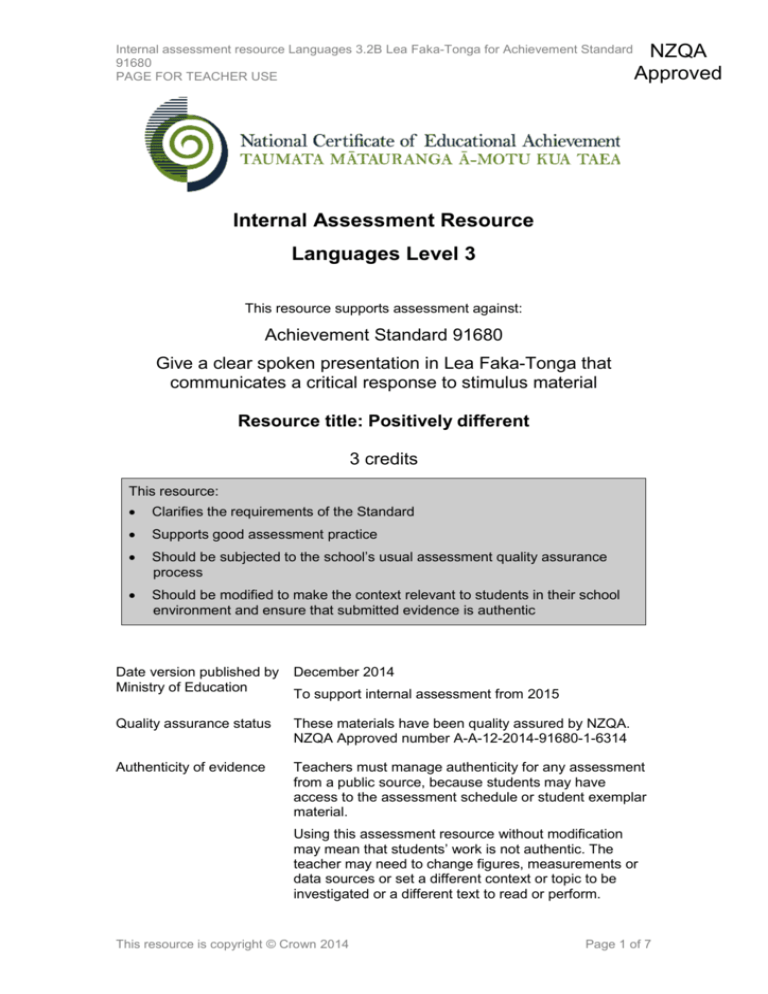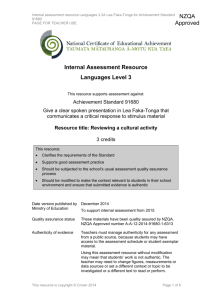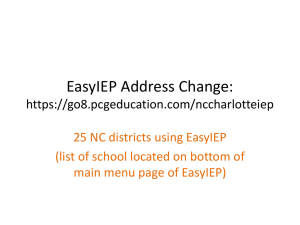Level 3 Languages internal assessment resource
advertisement

Internal assessment resource Languages 3.2B Lea Faka-Tonga for Achievement Standard 91680 PAGE FOR TEACHER USE NZQA Approved Internal Assessment Resource Languages Level 3 This resource supports assessment against: Achievement Standard 91680 Give a clear spoken presentation in Lea Faka-Tonga that communicates a critical response to stimulus material Resource title: Positively different 3 credits This resource: Clarifies the requirements of the Standard Supports good assessment practice Should be subjected to the school’s usual assessment quality assurance process Should be modified to make the context relevant to students in their school environment and ensure that submitted evidence is authentic Date version published by Ministry of Education December 2014 Quality assurance status These materials have been quality assured by NZQA. NZQA Approved number A-A-12-2014-91680-1-6314 Authenticity of evidence Teachers must manage authenticity for any assessment from a public source, because students may have access to the assessment schedule or student exemplar material. To support internal assessment from 2015 Using this assessment resource without modification may mean that students’ work is not authentic. The teacher may need to change figures, measurements or data sources or set a different context or topic to be investigated or a different text to read or perform. This resource is copyright © Crown 2014 Page 1 of 7 Internal assessment resource Languages 3.2B Lea Faka-Tonga for Achievement Standard 91680 PAGE FOR TEACHER USE Internal Assessment Resource Achievement Standard Languages 91680: Give a clear spoken presentation in Lea Faka-Tonga that communicates a critical response to stimulus material Resource reference: Languages 3.2B Lea Faka-Tonga Resource title: Positively different Credits: 3 Teacher guidelines The following guidelines are supplied to enable teachers to carry out valid and consistent assessment using this internal assessment resource. Teachers need to be very familiar with the outcome being assessed by Achievement Standard Languages 91680. The achievement criteria and the explanatory notes contain information, definitions, and requirements that are crucial when interpreting the Standard and assessing students against it. Context/setting This activity requires students to select from stimulus material a cultural practice or trend of the Tongans that they would like their classmates to experience. They then give a clear spoken presentation, in which they communicate a critical response to the stimulus material. The stimulus material could be, for example, a video clip, an article, or a text from a book. The cultural practice or trend could be, for example, street soccer, having Wednesday afternoons off, the one-child policy, no uniforms, cram schools, festivals, celebrations of national days, or the importance of church and religion. Choose stimulus material and suggest cultural aspects that will engage your students’ interests and that offers plenty of scope for students to engage with ideas in ways that are expected at level 8 of the curriculum. The student can research their chosen cultural practice/trend further, using other resources. This resource material should be read in conjunction with: the Senior Secondary Teaching and Learning Guides for languages http://seniorsecondary.tki.org.nz/ NCEA Level 3 Languages Conditions of Assessment http://ncea.tki.org.nz/Resources-for-Internally-Assessed-Achievement-Standards Conditions This Standard assesses the student’s ability to speak in front of an audience and has effective communication as its focus. This resource is copyright © Crown 2014 Page 2 of 7 Internal assessment resource Languages 3.2B Lea Faka-Tonga for Achievement Standard 91680 PAGE FOR TEACHER USE You will need to specify the amount of class time that the student has to prepare their presentation and allow class time for all of the students to give their presentations to their classmates. The students may work in pairs or in groups for their initial preparation and brainstorming but they will give their presentations and be assessed individually. The presentations will be given in front of the class and recorded for assessment purposes. Provided a student’s presentation meets the communicative purpose of the task, the length may vary. A length of about two to three minutes is suggested. However, at all times quality is more important than length. Resource requirements Audio and video recording equipment. Additional information None. This resource is copyright © Crown 2014 Page 3 of 7 Internal assessment resource Languages 3.2B Lea Faka-Tonga for Achievement Standard 91680 PAGE FOR STUDENT USE Internal Assessment Resource Achievement Standard Languages 91680: Give a clear spoken presentation in Lea Faka-Tonga that communicates a critical response to stimulus material Resource reference: Languages 3.2B Lea Faka-Tonga Resource title: Positively different Credits: 3 Achievement Give a clear spoken presentation in Lea FakaTonga that communicates a critical response to stimulus material. Achievement with Merit Give a clear, convincing spoken presentation in Lea Faka-Tonga that communicates a critical response to stimulus material. Achievement with Excellence Give a clear, effective spoken presentation in Lea FakaTonga that communicates a critical response to stimulus material. Student instructions Introduction This assessment activity requires you to prepare and give a clear spoken presentation in which you explain a cultural practice or trend and explain, with reasons, why you believe it would be beneficial for your classmates to experience it. Teacher note: You will need to add information about the stimulus material the students will be using. You will also need to let them know how their presentations will be recorded and stored. You may work in pairs or in groups for your initial preparation and brainstorming. But you will give your presentation and be assessed individually. You will present your presentation to your classmates in class time. You can use prepared notes, cue cards, props, photos, and other supporting material but you must not read directly from your notes. If you read directly from your notes, you will not meet the Standard. Your presentation must be your own work. If you include extracts from external sources, you must acknowledge those sources. Any extracts will not contribute towards your final grade. You may not use language from the language samples unless it has been significantly reworked. Your teacher will tell you how your presentation will be recorded and stored. The suggested length for your presentation is about two to three minutes. However, quality is more important than quantity. You will be assessed on how effectively you communicate a critical response to the cultural practice/trend. This resource is copyright © Crown 2014 Page 4 of 7 Internal assessment resource Languages 3.2B Lea Faka-Tonga for Achievement Standard 91680 PAGE FOR STUDENT USE Task Prepare and give a clear spoken presentation in Lea Faka-Tonga in which you explain a Tongan cultural practice/trend and explain, with reasons, why you believe it would be beneficial for your classmates to experience it. The practice/trend will be selected from stimulus material. Your presentation must be more than just a description of the practice/trend: “a critical response” will include analysis, interpretation, or evaluation. Whether you are expressing your own viewpoint or supporting or challenging the ideas or opinions of others, explain and justify your thinking. In your presentation, you could include, for example: a description of the cultural practice/trend (who, when, where, what) your first impressions and/or reactions upon learning about this practice/trend the reasons why this practice/trend appeals to you the benefits of this practice/trend for your classmates the origin and/or significance of the practice/trend in Tonga how the practice/trend differs from what you are used to, and how learning about this practice/trend has impacted on you (for example, change of point of view, a change of appreciation, belief, values) a prediction as to how your classmates might react to the practice/trend: challenge preconceptions, prejudice, stereotyping how you would introduce the practice/trend to your classmates specifics from the stimulus material and other related texts or images, or anecdotal evidence. The above suggestions are just some of the ways in which you could communicate a critical response to the cultural activity. In your presentation, you may want to comment on different aspects and in different ways. In your presentation, aim to: give a balanced view of the cultural aspect structure your argument logically and effectively to inform the audience and persuade them to accept your position use a range of language and language features that are fit for the purpose of the presentation and the audience minimise inconsistencies (for example, in vocabulary, expressions, sentence structures, pronunciation, intonation, rhythm patterns, delivery speed, audibility, stress, and tones) that could hinder communication use gestures and body language as appropriate in Lea Faka-Tonga. This resource is copyright © Crown 2014 Page 5 of 7 Internal assessment resource Languages 3.2B Lea Faka-Tonga for Achievement Standard 91680 PAGE FOR TEACHER USE Assessment schedule: Languages 91680 Lea Faka-Tonga – Positively different Evidence/Judgements for Achievement Evidence/Judgements for Achievement with Merit Evidence/Judgements for Achievement with Excellence The student gives a clear spoken presentation in Lea Faka-Tonga in which they explain a cultural practice or trend. The student communicates a critical response to stimulus material, that is, the presentation includes analysis, interpretation, or evaluation of stimulus material. The presentation explains and justifies a viewpoint, for example, the student shares personal perspectives and explores the views of others. The student includes New Zealand Curriculum level 8 communication skills, language, and cultural knowledge that are appropriate for the task and the intended audience, for example: Na‘a´ ku fiefia lahi he mahu‘inga‘ia ‘a Len Brown ke ne poupou‘i au ko e taha e fānau Tonga ‘i Aotearoa ke u manako ki he ako ‘a e hiva mo e faiva faka-Tonga´. Na‘a ne faka‘amu ke kei poupou mai ‘a e Pule‘anga´ ki he kātoanga mahu‘inga´ ni. Ko e kātoanga lahi taha eni he Pasifiki´ pea ‘oku´ ne fakahā ‘a e mahu‘inga ke poto ‘a e fānau Pasifiki´ ‘i he‘enau hiva´ mo e faiva fakafonua. The student gives a clear, convincing spoken presentation in Lea Faka-Tonga in which they explain a cultural practice or trend. The student communicates a critical response to stimulus material, that is, the presentation includes analysis, interpretation, or evaluation of stimulus material. The presentation explains and justifies a viewpoint, for example, the student shares personal perspectives and explores the views of others. The language is generally credible and connected. The student selects and uses a range of language and language features that are fit for the purpose and audience. The student includes New Zealand Curriculum level 8 communication skills, language, and cultural knowledge that are appropriate for the task and the intended audience, for example: ‘Oku ou poupou‘i lahi ‘a e lau ‘a e Meia´ pea fielau he na‘e tupu hake ‘i ‘Ōtala ‘o feohi mo e kakai Mauli´mo e Pasifiki´ pea ‘oku mahino ki ai hotau anga fakafonua´. Na‘e pehē ‘e he Meia´, Len Brown, ‘oku ‘ikai ke fiemālie ki he me‘a ‘a e Palēmia´ he ko e taha eni e founga ke poupou‘i ai ‘e he Pule‘anga´ e ako ‘a e fānau Mauli´ mo e Pasifiki´. Ko e konga mahu‘inga ia ‘e taha ‘enau ako´ ko ‘enau poto ‘i he‘enau ngaahi hiva´mo ‘enau ngaahi faiva fakafonua´. The student gives a clear, effective spoken presentation in Lea Faka-Tonga in which they explain a cultural practice or trend. The student communicates a critical response to stimulus material, that is, the presentation includes analysis, interpretation, or evaluation of stimulus material. The presentation explains and justifies a viewpoint, for example, the student shares personal perspectives and explores the views of others. The language is controlled and integrated. The student capably selects and successfully uses a range of language and language features that are fit for the purpose and audience. The student includes New Zealand Curriculum level 8 communication skills, language, and cultural knowledge that are appropriate for the task and the intended audience, for example: Na‘e ‘ikai ke fiemālie ‘a John Key, ki he fu‘u lahi ‘o e ngaahi fakamole ‘oku fai ‘e he Meia ‘o ‘Okalani´ ki hono fakalele ‘o e kātoanga faiva fakata‘u ‘a e fānau ako Mauli´ mo e Pasifiki´. Ka na‘e pehē 'e Len Brown “ko e taha eni ha fakamole ‘aonga he ko e kātoanga pē ‘eni ‘e taha ‘oku faka‘ali‘ali ai ‘e he fānau Mauli´ mo e Pasifiki´ ‘enau ngaahi hiva´ mo e faiva´. ‘Oku ‘omai ‘e he lea ‘o e hiva´ mo e haka ‘o e faiva´ ‘a e ngaahi ‘ilo fo‘ou ki he fānau´ pea ‘oku nau pōlepole ai ke nau pukepuke ‘a fufula ‘enau ngaahi faiva tu‘ufonua´.” Communication is not significantly hindered by inconsistencies (in, for example, language features, pronunciation, intonation, gesture, rhythm patterns, delivery speed or audibility, stress patterns, or tones). Ko ia ai ‘oku ou poupou‘i 'a e Meia´ he ‘oku lahi ‘a e fakamole noa‘ia ‘a e Pule‘anga´, ka ‘oku ‘ikai te nau poupou‘i ‘a e ako ‘a e fānau Mauli´ mo e Pasifiki´. Communication is achieved overall despite inconsistencies (in, for example, language features, pronunciation, intonation, gesture, rhythm patterns, delivery speed or audibility, stress patterns, or tones). The example above relates to only part of what is required, and is just indicative. This resource is copyright © Crown 2014 Page 6 of 7 Internal assessment resource Languages 3.2B Lea Faka-Tonga for Achievement Standard 91680 PAGE FOR TEACHER USE The example above relates to only part of what is required, and is just indicative. Communication is not hindered by inconsistencies (in, for example, language features, pronunciation, intonation, gesture, rhythm patterns, delivery speed or audibility, stress patterns, or tones). The example above relates to only part of what is required, and is just indicative. Final grades will be decided using professional judgement based on a holistic examination of the evidence provided against the criteria in the Achievement Standard. This resource is copyright © Crown 2014 Page 7 of 7







